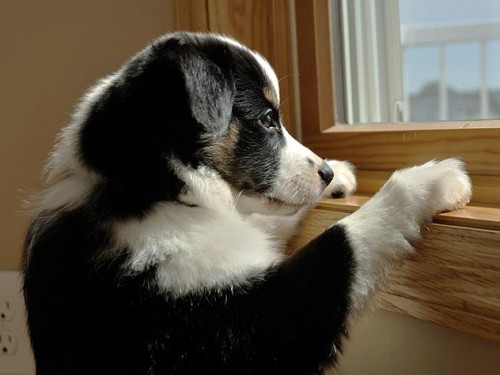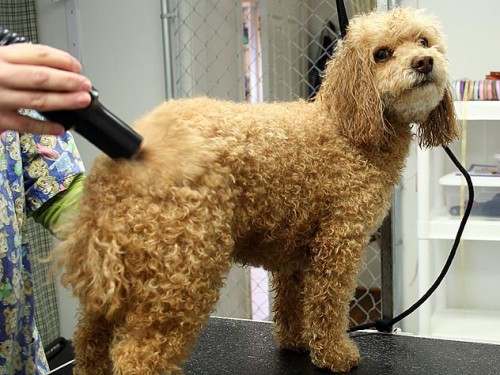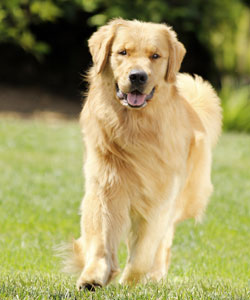How to Praise a Dog in Training
Know When To Use Praise
Dogs don’t understand cause and effect unless one comes immediately after the other. When you praise your dog, he thinks he’s being praised for whatever he just did. So it’s important to say “good dog” or give a small treat the moment he does the desired action. It works the same way for reinforcing a command your dog has already learned. If your dog reliably lies down every time you say “down,” you should still praise him every time he does it, but praise him the moment he does it. If you wait another moment, he might stand up, and then he’ll think that’s what you’re praising him for.
Do Not Praise Inappropriate Behavior
This may seem obvious, but many dog owners reward inappropriate behavior by inadvertently giving their dog positive reinforcement. For example, if your dog greets you at the door barking, and you respond by hugging him and speaking to him in either an enthusiastic or a consoling tone, your dog will think you are pleased with the behavior and he’ll keep doing it. The best way to handle unwanted behavior is to ignore it. The moment your dog stops barking, or whatever he’s doing that he shouldn’t be doing, praise him lavishly.
Back-to-School Separation Anxiety

With this sudden change in daily routine, your dog may experience depression or separation anxiety. Separation anxiety is triggered when dogs become upset because of separation from the people they’re attached to.
Signs your dog might be suffering from separation anxiety include destructive or anxious behaviors like:
Howling
Chewing
Pacing
Housesoiling
Attempting to escape from the house or yard
The good news is there are things you can do to help relieve your pup’s distress. The Oregon Humane Society offers these tips to help your dog overcome the “back-to-school blues.”
Schedule an appointment with your vet. Your dog’s anxiety might have an underlying medical cause or your vet might have some additional ideas to help relieve your dog’s stress.
Consider preparing Kongs stuffed with peanut butter or some other favorite treat. Working to get the treat out will provide your dog a distraction from his stress and hours of enjoyment and mental stimulation while you’re gone.
Check out some doggie day cares in your area. A day or two of supervised play and exercise may be beneficial to your lonely dog.
Take your pooch for long morning walks to get him plenty of exercise and tire him out.
Spend quality time with your dog when you are at home; include him in family activities to assure him he’s still an important part of the family.
Does Treatment for Heartworms Shorten a Dog’s Life Expectancy?
The Truth about Heartworms
Dirofilaria immitis, or heartworms, are found throughout most of the United States. Dogs come down with heartworm when bitten by a infected mosquito carrying the parasite’s microscopic larvae. If a dog is exposed to infected larvae, it’s a virtual certainty he’ll come down with heartworm disease. The number of heartworms infecting a dog can range from a single specimen to more than 250, according to the American Heartworm Society. They usually congregate in the heart’s right ventricle or the pulmonary arteries. Heartworms can reach a foot in length, living five years or more.
Does Your Dog Have Them?
It takes approximately seven months for larvae to grow to adulthood in a dog’s body. In the early stages of infestation, dogs are asymptomatic. As the heartworms grow, affected dogs develop a cough. Symptoms progress to include exercise intolerance and abnormal breathing. Signs of severe heartworm infestation include abnormal cardiac sounds, abdominal fluid accumulation and coma. Dogs might suddenly die.
Treatment Options
The U.S. Food and Drug Administration has approved two medications for heartworm eradication in canines. Thiacetarsamide sodium, an older treatment administered intravenously, can cause numerous side effects in dogs because of its toxicity. A newer drug, Melarsomine dihydrochloride, is injected intramuscularly deeply into the lumbar area.
What’s the Prognosis?
Once heartworm drugs are administered, the worms start dying off. The dead worms break into pieces, which can cause a pulmonary blockage in your dog, killing him. It’s crucial that dogs undergoing heartworm treatment remain calm and quiet both during the treatment and for months afterward. It’s not easy to keep a young dog confined with minimal exercise for long periods, but it’s the best way to keep heartworm bits from heading into the lungs. When treatment is over, your dog receives medication to kill off the baby heartworms, or microfilaria.
Heartworm Prevention
A monthly heartworm preventative in tablet form or topically applied can keep your dog free from the travails of heartworm disease. Your vet must take a blood sample to ensure your dog is heartworm-free before prescribing the medication. Depending where you live, heartworm tablets or medications are given seasonally or year-round.
The Effect of Salt on a Dog’s Health
Sodium
Many people think of salt and automatically think of sodium, although the two are not exactly one and the same. Sodium is just one part of salt, as it also includes chloride. The bulk of commercial canine foods available on the market contain some salt. Talk to your veterinarian to get suggestions on dog foods that have appropriate levels of sodium. At suitable levels, sodium actually is helpful in dogs’ physiology, assisting in equilibrium of fluids.
Say No to Dogs and Salty Food
Too much salty food and dogs are not a good combination, however. If your dog enviously stares at you as you eat a salty French fry, don’t give in to the urge to feed him a bunch of them — or even one of them. If your dog takes in a lot of salt, it could trigger numerous not-so-pleasant health consequences, including immoderate urination, seizures, heightened thirst, uncontrollable quivering, depression, throwing up, runny stools and raised body temperature. Sodium ion toxicity in dogs can sometimes even be life-threatening, so take the possibility extremely seriously. Urgent veterinary assistance is crucial in these situations.
Dogs With Kidney or Heart Issues
The effects of salt might be even more harmful to specific types of dogs. If your pet has any medical ailments that involve the kidneys or the heart, then a veterinarian might recommend for him a diet that is limited in salt content. This also applies to canines with hypertension. Be extremely cautious about leaving salty food out around your dog, whether he has these health issues or not.
Inadequate Sodium
Just as too much sodium can be detrimental to a dog’s health, so can too little of it. If your pooch isn’t getting adequate amounts of sodium in his canine food, you might notice key symptoms such as lethargy, overly dry skin, growth problems, balance issues, fur loss, reduced H20 consumption and low energy. If you spot any of those clues in your doggie, talk to your veterinarian about planning for a nutritious diet that offers the amounts of sodium that his body needs for optimal health.
How to Find A Good Groomer
Grooming is an essential part of our pets’ health and hygiene. Pets with healthy, clean coats are happier animals! While some dogs and cats are easy to bathe and brush at home, others need regular trips to the groomer.
Here are some tips for finding the best groomer for you:
Ask for referrals

The Internet is also a great tool to do research. Many sites, such as Petfinder’s Local Service and Supplies listings, allow users to leave reviews — a great tool for research.
Your veterinarian may also be a great resource for finding a groomer. Using a groomer that both you and your veterinarian trust is ideal.
A good grooming facility will require vaccination papers from your vet. This helps to ensure that your pet will not contract any disease or infections from other animals at the facility. Regardless of a vet-recommended groomer, you should always leave the contact number of your vet in case of an emergency.
Questions to ask
Everyone wants to know that the groomer has your pets’ safety in mind. Find out if your town requires groomers to be licensed. This ensures that a groomer adheres to certain guidelines. When doing your research, don’t forget to ask the groomer if she is licensed.
Ask your groomer what her policy is if an accident occurs. It is crucial that your groomer be honest and let you know if anything occurs while you left your pet in her hands.
While accidents, such as cuts, scrapes and burns, can happen anywhere, it is important to check your groomer’s credentials first. Look into past accident reports or client complaints whenever possible.
What to look for at the grooming facility
Take your pet with you for a tour of the facilities before your pet’s first grooming appointment. This will give you an opportunity to see how the groomer interacts with other pets and you can ask other pet owners about their experiences with the groomer.
Your pet should become somewhat familiar with the place, and you should feel comfortable leaving your pet there. Be sure that pets are never left unattended while on the grooming table or in the tub.
While visiting, introduce yourself and your pet to the groomer and staff. This will help to make the next visit easier on your pet. Be sure to check that the facility is clean and equipment is sanitary.
What to tell your groomer
You need to discuss any health issues that your pet may have with your groomer. If your pet has specific skin problems, your veterinarian may want your groomer to use a certain shampoo on your pet.
Typically, veterinarians will not want a pet to visit the groomer if they have just undergone a surgical procedure — especially if they have stitches. Be sure to ask your vet about grooming restrictions after any veterinary procedure.
Your groomer is there to help keep your pets’ skin, ears and nails healthy and in good condition. They can be a great resource for noticing ear infections and other skin related issues, which you can then discuss with your veterinarian.
Your Athletic Dog’s Diet

You can determine whether your dog eats enough calories based on his demeanor, appearance and weight. Does your dog seem depressed or lethargic? Does he seem less energetic than normal? Is he ravenous at mealtimes? If so, you may need to feed him additional food or higher energy foods.
Check your dog’s ribs and examine his body outline from an overhead perspective. If you see extra padding over his ribs and no sign of his waist, you are probably feeding too much. Cut down on the dog’s portions or bulk out his meals with lower-calorie foods, such as brown rice. If his ribs are starkly evident and his waist a little too pronounced, he needs more calories. Finally, invest in an accurate scale and weigh your dog on a regular basis. After a while, you’ll be able to pinpoint an ideal weight for your dog. Note that this weight may vary according to the seasons.
You’ll need to adjust the amount you feed on a weekly or even daily basis. The energy a dog requires varies with climate, amount of exercise, stress, breed and the quirks of each individual dog. Most veterinarians recommend you feed your athletic dog two to three meals each day, with the largest meal served at least an hour after the exercise session. A large meal before strenuous exercise can cause indigestion, cramps and other health problems.
You can provide the additional energy your active dog requires during the cold weather two ways: Feed more of the food you already give your dog, or feed him foods that are more tightly packed with nutrients.
To provide the highest level of energy, look for fatty foods. Fats yield more than twice as much energy as similar amounts of carbohydrates or proteins, and smaller amounts of food can supply a larger amount of energy. To help process these additional fats, your dog will also need higher levels of protein. In addition, you may add supplements to your dog’s diet to boost his energy levels and counteract the effects of vigorous exercise.
How much fat and protein should a dog have in his daily diet?
In general, high-energy homemade canine diets range from 15 percent to 25 percent fat, and from 30 percent to 40 percent protein; commercial high-performance diets offer 10 percent to 18 percent fat, and 24 percent to 28 percent protein. Whether you are feeding an off-the-shelf diet, making it yourself or some combination of the two, you can easily raise the fat levels your dog’s diet.
Two kinds of fat can be added to your dog’s diet: fat derived from animal sources, which are saturated fats, and fats derived from plant sources, which are polyunsaturated fats. Animal-derived fats offer the highest levels of energy and are the best high-energy supplements.
Plant-derived fats, easily available in vegetable oils, will make your dog’s skin and coat pretty, but they won’t add the desired energy jolt. Plant fats contain fatty acids, which are vital for healthy coats and shiny skin.
If your dog is active, but not super-active, try feeding him larger amounts of his regular diet before switching to the high-energy diet. If that doesn’t seem to satisfy your dog’s energy needs, try adding a little bit of fatty meat, such as chopped or ground beef heart, hamburger, fatty chuck, sirloin steak, lamb or pork, to his meals or increasing the use of fattier cuts of meat in your dog food recipe.
If your dog is super-active, you’ll have to add larger amounts of high-octane foods to his meals. One way is to save the meat drippings from your meals of roasted beef, chicken or turkey. (Be sure it does not contain sugar, artificial preservatives or chemicals, or high sodium levels.) You can also make special arrangements with your organic meat supplier to purchase fresh, pure poultry fat or beef tallow. Poultry fat is much preferred by owners of canine athletes because it is highly digestible and also contains the fatty acids that contribute to a shiny coat. Be careful when adding fat to your dog’s diet, though. If the dog eats solely the fat or too much of the fatty meat and not enough of his other food, it will lack necessary protein and carbohydrates.
What Dog Breeds Have Five Toes on Their Hind Legs?
An Evolutionary Throwback
Dogs normally considered to be “flock guardians” present an extra hind toe or dewclaw most frequently. These breeds would include the Anatolian shepherd, Australian shepherd, rottweiler, shih tzu, standard poodle, and many Asian breeds including the shiba inu, akita, jindo, sasparee and Korean tosa. The great Pyrenees is the most commonly known polydactyl canine, and may even present six hind toes. The Norwegian Lundehund may present five toes on both his front and hind feet. In a study supported by the Korean Research Foundation and the Korea Science and Engineering Foundation, scientists came to the conclusion that the presentation of a fifth toe, most accurately called polydactyly, is a reversion from the evolutionary loss of the toe.
Caring for Dewclaws
A polydactyl dog’s dewclaw may be attached by bone or solely by skin. Dewclaws may be removed surgically to prevent them from getting caught on objects, which can cause injury to the dog. If not removed, the toenail should be trimmed regularly to prevent it from causing sores or other injury to the rest of the leg and foot.





